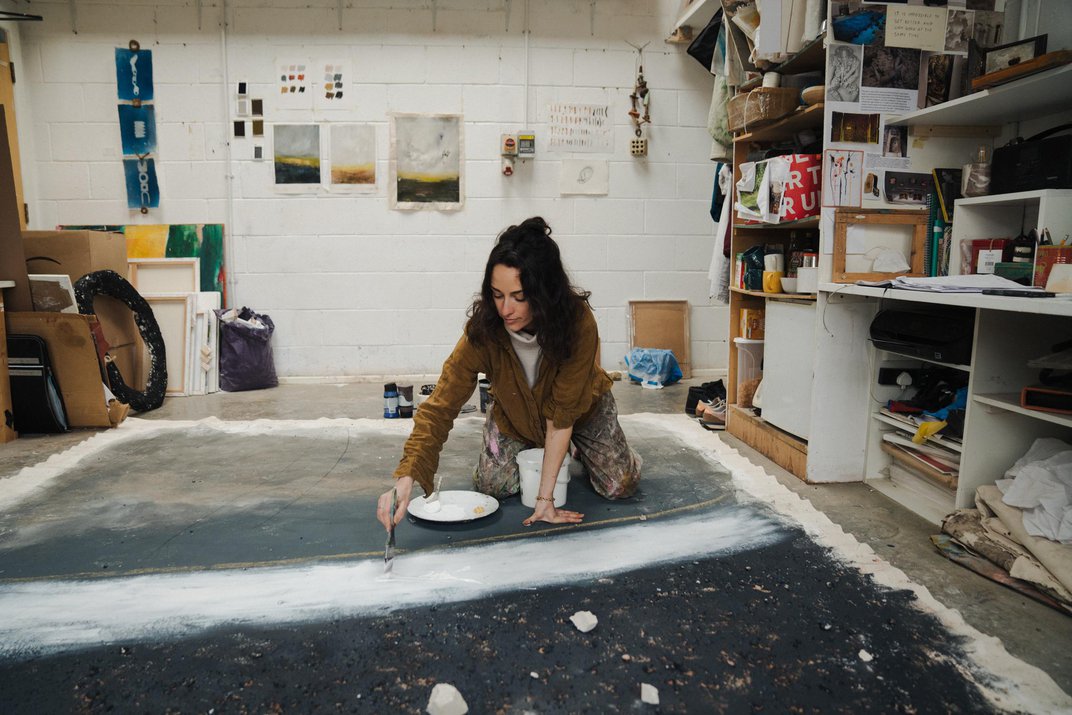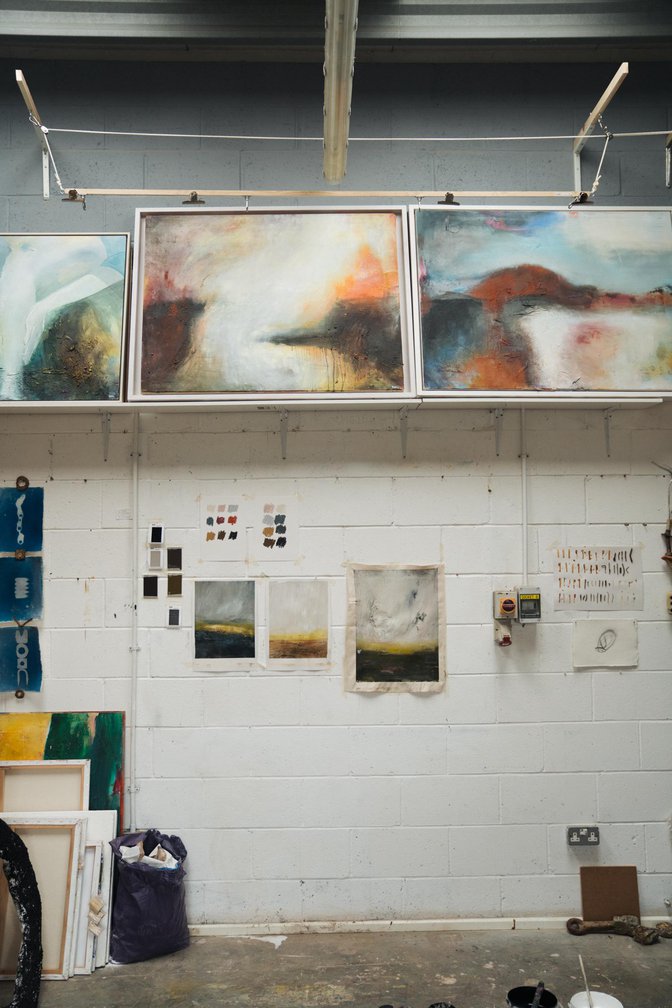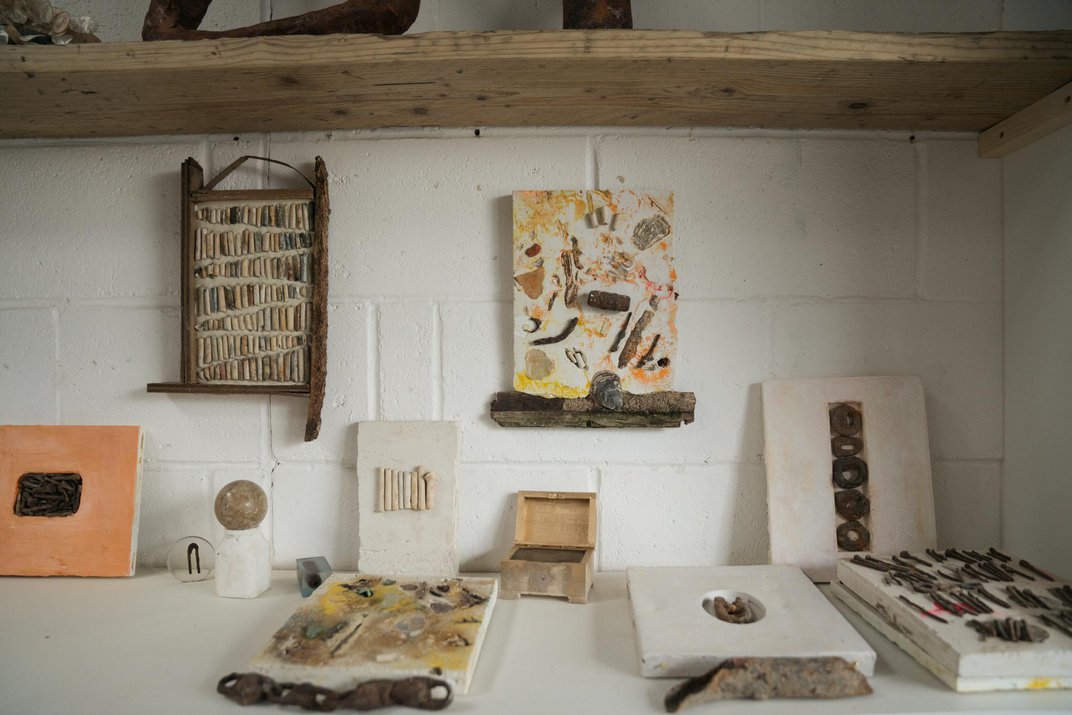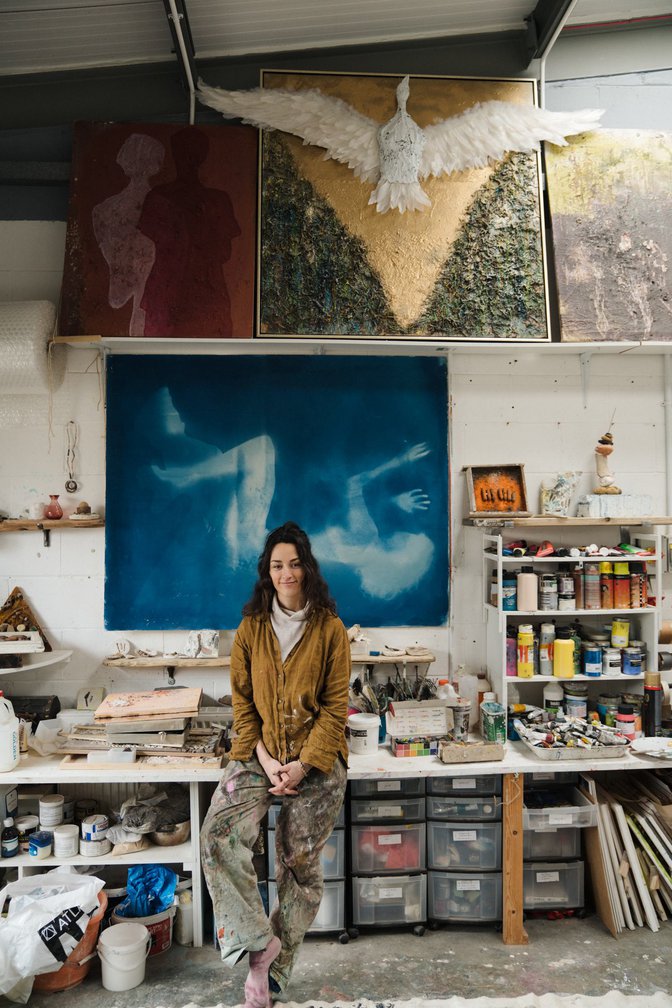article In conversation with
Georgie Mason
In conversation with
Georgie Mason
Georgie Mason

Working across sculpture, painting and
music, Georgie Mason's practice is a response
to her personal journey into understanding
the unconscious mind and unifying
inner opposites.
music, Georgie Mason's practice is a response
to her personal journey into understanding
the unconscious mind and unifying
inner opposites.
Working across sculpture, painting and
music, Georgie Mason's practice is a response
to her personal journey into understanding
the unconscious mind and unifying
inner opposites.
Georgie Mason is an artist based in East London, working from her studio located at Stepney City Farm. When not distracted by the animals, she creates interdisciplinary works in response to her personal journey into understanding the unconscious mind and unifying inner opposites. A deep interest in Jungian theory, inner alchemy and energetic healing informs her practise.
Collecting scattered and buried objects from the shore of the Thames as a metaphor for searching beneath the layers of the psyche for the parts of ourselves we bury, Georgie later recontextualizes these objects and explores the relationship between them.
Collecting scattered and buried objects from the shore of the Thames as a metaphor for searching beneath the layers of the psyche for the parts of ourselves we bury, Georgie later recontextualizes these objects and explores the relationship between them.

Artiq When was the moment you realised you were going to be an artist?
Georgie I never had a moment of realisation that I would always make art, as that was a given. But about a decade ago, my friend and I rented an art space and curated a duo show during the summer holidays of my second year of university (where I was studying English Literature). Before we’d officially opened the show, someone walked in from the street and bought a painting - that was the first time I thought I could actually make money doing something I love.
Artiq Reclaimed materials are central in your practice, especially in your series “An Archaeology of Soul”. How does your creative process support the themes you wish to explore in your art?
Georgie The main themes I am exploring at the moment are artistic and psychological alchemy, connecting with a universal, timeless energy that I believe runs through everything, and uniting inner opposites such as dark and light or feminine and masculine (energetics, separate from gender). My creative process is intricately interwoven within those themes: I prospect for materials at the foreshore of the Thames, which I find to be a fascinating space that contains history within its spirit and materiality.
For example, the physical bones and teeth of robbers and rebels who were executed at the dock are still buried under pebbles; parts of old shipwrecks are hiding amongst the pebbles; old clay pipes and rusty laughing gas canisters are scattered around, each telling their own story - a portal to the past. The beach is also a threshold space straddling the underworld and reality, water and air, unseen and seen.
The cyclical nature of the waves, washing objects up repeatedly, mimics the sublimation-distillation process within the alchemy, of excavating under the surface to reveal what’s hidden. So, by being in this space and working with meaningful and agential matter, I am guided, through a process that is not entirely self-originating, to make artworks that become symbols of and catalysts for inner transformation.
Georgie I never had a moment of realisation that I would always make art, as that was a given. But about a decade ago, my friend and I rented an art space and curated a duo show during the summer holidays of my second year of university (where I was studying English Literature). Before we’d officially opened the show, someone walked in from the street and bought a painting - that was the first time I thought I could actually make money doing something I love.
Artiq Reclaimed materials are central in your practice, especially in your series “An Archaeology of Soul”. How does your creative process support the themes you wish to explore in your art?
Georgie The main themes I am exploring at the moment are artistic and psychological alchemy, connecting with a universal, timeless energy that I believe runs through everything, and uniting inner opposites such as dark and light or feminine and masculine (energetics, separate from gender). My creative process is intricately interwoven within those themes: I prospect for materials at the foreshore of the Thames, which I find to be a fascinating space that contains history within its spirit and materiality.
For example, the physical bones and teeth of robbers and rebels who were executed at the dock are still buried under pebbles; parts of old shipwrecks are hiding amongst the pebbles; old clay pipes and rusty laughing gas canisters are scattered around, each telling their own story - a portal to the past. The beach is also a threshold space straddling the underworld and reality, water and air, unseen and seen.
The cyclical nature of the waves, washing objects up repeatedly, mimics the sublimation-distillation process within the alchemy, of excavating under the surface to reveal what’s hidden. So, by being in this space and working with meaningful and agential matter, I am guided, through a process that is not entirely self-originating, to make artworks that become symbols of and catalysts for inner transformation.

Artiq Could you please tell us a bit more about the influence that Jungian Psychology had and still have on your work?
Georgie Jung talks about the ‘shadow side’ - the repressed aspects of the psyche, or the parts of us that are anathema to our ideal self-image. He theorised that unless we become aware of these shadow parts they will rule our life unconsciously and we’ll call it fate. I’m a bit obsessed with ‘excavating’ down into my psyche and dredging up parts of myself that were previously unconscious - it’s a process that never ends! Once you are aware of these unconscious parts they no longer have a hold on your life so it’s very freeing.
My work is like a way of practising excavation techniques before implementing them on myself. So, for example, sometimes I bury foreshore found objects inside plaster trays, then take them out and use sandpaper or hammers to reveal what I’ve just buried. It’s a metaphor for using meditation / somatic therapies to expose habitual thought patterns or release big, old stored emotions. My practice keeps me connected to the lifelong process of inner transformation, in a way that feels exciting and beautiful.
Artiq You’ve recently been part of the “Works on Paper 5” exhibition at Blue Shop Gallery. Congratulations! The show features some of your works on paper, one of the many media you explore in your practice. Do you gravitate towards different techniques and supports for each idea?
Georgie Thank you! Cyanotypes definitely work in tandem with the themes and materiality of my other recent work: their X-ray blurriness speaks to the clarity but inevitable opacity of shadow-work and self-excavation, whilst the smudgy gradation between tonalities alludes to the ancestral imprint of the past on the present.
I definitely enjoy the connections between various techniques and media and the way they can speak to one another to bring different perspectives and interpretations of the same themes. I’ve also started bringing music into my practice to add another dimension. I feel that together, different aspects can create an installation that is richer and more whole than the sum of its parts.
Georgie Jung talks about the ‘shadow side’ - the repressed aspects of the psyche, or the parts of us that are anathema to our ideal self-image. He theorised that unless we become aware of these shadow parts they will rule our life unconsciously and we’ll call it fate. I’m a bit obsessed with ‘excavating’ down into my psyche and dredging up parts of myself that were previously unconscious - it’s a process that never ends! Once you are aware of these unconscious parts they no longer have a hold on your life so it’s very freeing.
My work is like a way of practising excavation techniques before implementing them on myself. So, for example, sometimes I bury foreshore found objects inside plaster trays, then take them out and use sandpaper or hammers to reveal what I’ve just buried. It’s a metaphor for using meditation / somatic therapies to expose habitual thought patterns or release big, old stored emotions. My practice keeps me connected to the lifelong process of inner transformation, in a way that feels exciting and beautiful.
Artiq You’ve recently been part of the “Works on Paper 5” exhibition at Blue Shop Gallery. Congratulations! The show features some of your works on paper, one of the many media you explore in your practice. Do you gravitate towards different techniques and supports for each idea?
Georgie Thank you! Cyanotypes definitely work in tandem with the themes and materiality of my other recent work: their X-ray blurriness speaks to the clarity but inevitable opacity of shadow-work and self-excavation, whilst the smudgy gradation between tonalities alludes to the ancestral imprint of the past on the present.
I definitely enjoy the connections between various techniques and media and the way they can speak to one another to bring different perspectives and interpretations of the same themes. I’ve also started bringing music into my practice to add another dimension. I feel that together, different aspects can create an installation that is richer and more whole than the sum of its parts.


Artiq What do you want the audience to take away from your work?
Georgie I can’t dictate how the audience responds to my work and I’m not trying to elicit a specific reaction. But I do believe that the symbolic weight encoded within the materials themselves has the capacity to transform viewers who enter, unconsciously or consciously, into their energetic space, and that an installation of these materials could become a space of shared human experience, compassion for self and other, and individual and collective transformation.
Artiq You offer workshops both from your studio and at other locations. What is the mission that motivated you to start this project?
Georgie To me, it is a small tragedy that so many people have been led to believe they are not creative just because they didn’t do well in art at school or they’re not technically skilled. To me, art is a natural mode of expressing emotions, connecting to one’s own authentic voice, and playing! The lightness of creativity can be forgotten in the seriousness and often inaccessibility of the art world. I think this is changing though, gradually, as the powerful effects of art-making are increasingly understood.
I know these benefits first-hand; art as a tool has helped me make many aspects of my unconscious conscious, and to practise skills such as letting go of control and trusting the process (in art and life). It is my mission to help dispel the myth of art-elitism and I could go on about how art, practised in the way I teach, is proven to decrease anxiety and depression, encourage more open-minded thinking, uplevel CQ (Creative Intelligence) and increase feelings of calm and clarity. But it’s better if you try it for yourself! (I would say book a class but I’m actually sold out all year, however, please feel free to have a gander and join the waitlist as cancellations do happen - and I’ll be adding more dates very soon).
Georgie I can’t dictate how the audience responds to my work and I’m not trying to elicit a specific reaction. But I do believe that the symbolic weight encoded within the materials themselves has the capacity to transform viewers who enter, unconsciously or consciously, into their energetic space, and that an installation of these materials could become a space of shared human experience, compassion for self and other, and individual and collective transformation.
Artiq You offer workshops both from your studio and at other locations. What is the mission that motivated you to start this project?
Georgie To me, it is a small tragedy that so many people have been led to believe they are not creative just because they didn’t do well in art at school or they’re not technically skilled. To me, art is a natural mode of expressing emotions, connecting to one’s own authentic voice, and playing! The lightness of creativity can be forgotten in the seriousness and often inaccessibility of the art world. I think this is changing though, gradually, as the powerful effects of art-making are increasingly understood.
I know these benefits first-hand; art as a tool has helped me make many aspects of my unconscious conscious, and to practise skills such as letting go of control and trusting the process (in art and life). It is my mission to help dispel the myth of art-elitism and I could go on about how art, practised in the way I teach, is proven to decrease anxiety and depression, encourage more open-minded thinking, uplevel CQ (Creative Intelligence) and increase feelings of calm and clarity. But it’s better if you try it for yourself! (I would say book a class but I’m actually sold out all year, however, please feel free to have a gander and join the waitlist as cancellations do happen - and I’ll be adding more dates very soon).
Artiq Are you currently working on something new? If so, could you share something about your upcoming projects?
Georgie I have the Final Show of my MA in Fine Art at City and Guilds University of the Arts London, from September 2-9. All are welcome!
I also have a Residency at PADA in Portugal during October and November which I’m sure will push my work in new directions. Following that I have a solo show at RuptureXhibit in March. In terms of my workshops, lots of exciting ideas and collaborations are in the pipeline…join my mailing list to keep in the loop!
Georgie I have the Final Show of my MA in Fine Art at City and Guilds University of the Arts London, from September 2-9. All are welcome!
I also have a Residency at PADA in Portugal during October and November which I’m sure will push my work in new directions. Following that I have a solo show at RuptureXhibit in March. In terms of my workshops, lots of exciting ideas and collaborations are in the pipeline…join my mailing list to keep in the loop!
